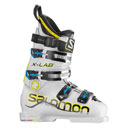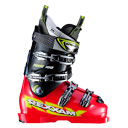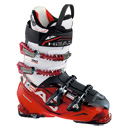如何挑選滑雪靴
競技滑雪,基礎滑雪,花樣滑雪,或挑戰貓跳等每位滑雪者的誌向不同,
選擇壹雙滑靴也會根據用途和使用目的而不同。
選定自身腳型的滑靴也非常地重要。
Point 1 滑雪靴的硬度和靴寬
| 柔韌性 | 腳後跟寬度 | 內膽靴 | ||
| 競賽 |  |
非常硬 | 非常狹窄 | 薄 |
| 基礎 |  |
硬 | 狹窄 | 薄~壹般 |
| 自由滑雪 |  |
壹般 | 寬 | 壹般 |
| 壹般(普通) |  |
壹般~柔 | 寬 | 厚~柔 |
| 女款 |  |
壹般~柔 | 壹般~寬 | 厚~柔 |
Point 2 根據滑雪者的使用目的和用途而選定
競技式滑靴的硬度是非常硬並且寬度非常狹窄設計。
通常,硬度標記為120~150、寬度為93~98mm左右。
為了滑雪選手改變方向施加壓力時,由於滑行時速度較快,
耐住由外而施加的離心力(滑靴會受各種外力和內力)而特意設計。
寬度為什麽設計為那麽狹窄?
競賽式的滑靴本身設計的非常細小,其內膽靴自身也非常硬並且非常薄。
這是因為緊包裹腳步,稍有壹點動力或壓力都可以很好的傳達雪板的目的而設計。
假設內膽靴如果海綿那樣蓬松寬厚設計的話,剛才那些壓力動力會被吸收不利於發揮實力。
基礎滑雪,常聽滑雪考第幾級但實際上,是指想提高滑雪技術的滑雪。
適用於基礎滑雪的滑靴,其硬度比競賽的要柔軟壹些,寬度也稍寬壹些設計。
通常,硬度標記為100~130、寬度為98~100mm左右。
根競賽滑雪相比,滑行速度會劣些但腳步舒適些較易操作。
花樣滑雪(高空旋轉)或貓跳等要靈活運用腳部因此硬度設計為80~100,寬度較廣100~104mm之間。
有些型號腳後跟著地時吸收震動會特殊設計,還有花樣滑雪型號的雪靴不需要緊的扣所以也有2扣,3扣的設計。
作為業余,純粹地享受滑雪的滑雪者該如何和選擇滑靴呢?
通常是硬度為70~100,寬度為102~106mm……
下壹個才是關鍵!
業余滑雪者追求的滑靴是舒適和腳脖不疼。
這樣的話,是不是應該選擇硬度軟,並且寬度寬的壹軟嗎?
答案是:不
在實體店試穿,感覺很舒適但在雪場滑行另當別論。
膝蓋前屈施加外力但由於硬度軟的話,大施加的外力被吸收板刃傳達不到力度。
另外,腳後跟太寬滑行時劃擦。
久而久之磨腳部疼痛。因此硬度軟寬度廣的雪靴雖然舒適但不利於滑雪。
既然這樣,如何選擇適合自己的雪靴呢?
整體而言穿上去腳不疼,又感覺被hold得住的雪靴(均勻地受壓迫)是最合適的。
要考慮進去的是,使用次數較多的雪靴內膽靴會被壓扁之前均勻受壓迫的地方弱些了。
多少緊些,如果沒有腳尖的局部疼痛以外,該款雪靴就是適合您腳型的雪靴。
我們大阪實體店專門為您測量腳步,根據您的尺寸和水準為您選定幾個雪靴。
如何選擇兒童滑雪靴
兒童滑雪靴的選擇
請選擇比平時穿的鞋子長1cm的滑雪鞋。
如果買和平時穿的鞋子壹樣的尺碼的話,對低年級兒童來說會比較擠腳。
(不包括競技水平的兒童)
挑選兒童滑雪鞋時,最在意的就是尺寸大小
由於兒童1.2年內會成長很快,因此很多家長都希望買較大尺碼的滑雪鞋。
但是這樣反而會影響孩子技術方面的提升。所以建議挑選比平時穿的鞋子尺寸大0.5~1cm。
壹般平時穿的鞋子比腳的實際尺寸大0.5~1cm,滑雪鞋要比平時鞋長0.5~1cm,
這
樣的話滑雪鞋就比腳的實際尺寸大1~2cm,如果超過這個範圍的話不利於滑雪。

到實體店的顧客,我們先為您提供幾款雪靴(平時穿的尺碼和大壹號的尺碼)。
在網上購買的消費者,建議選擇0.5~1cm大尺碼的雪靴。
如果買完發現大很多請裁剪大小調整鞋墊往裏墊墊即可。
(如果感覺稍微大的話,取出內膽靴中的鞋墊,然後按照鞋墊尺寸剪裁大小調整鞋墊。
隨後講鞋墊和大小調整鞋墊放進內膽靴裏就好。)
等長大了,把裏面的大小調整鞋墊拿走繼續可以使用。
如果不知道尺碼是否合身,取出內膽靴讓孩子試穿。
腳後跟對齊後,按下腳尖看看有多少空隙。如果有1cm左右的話,剛剛好。